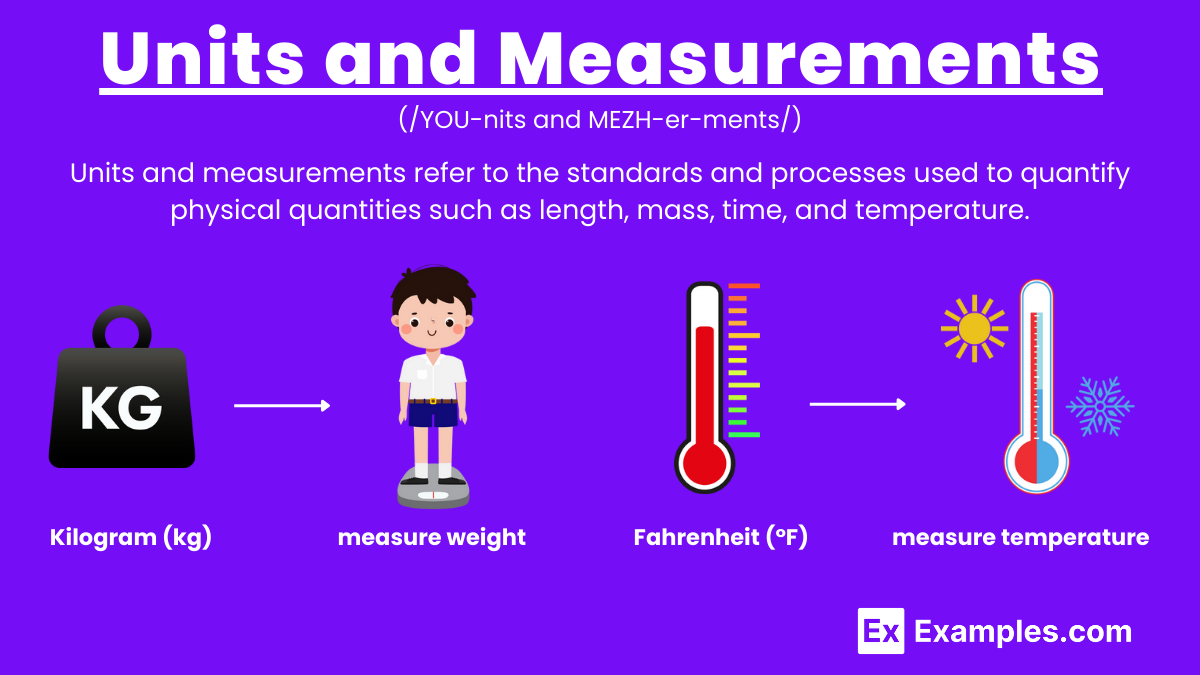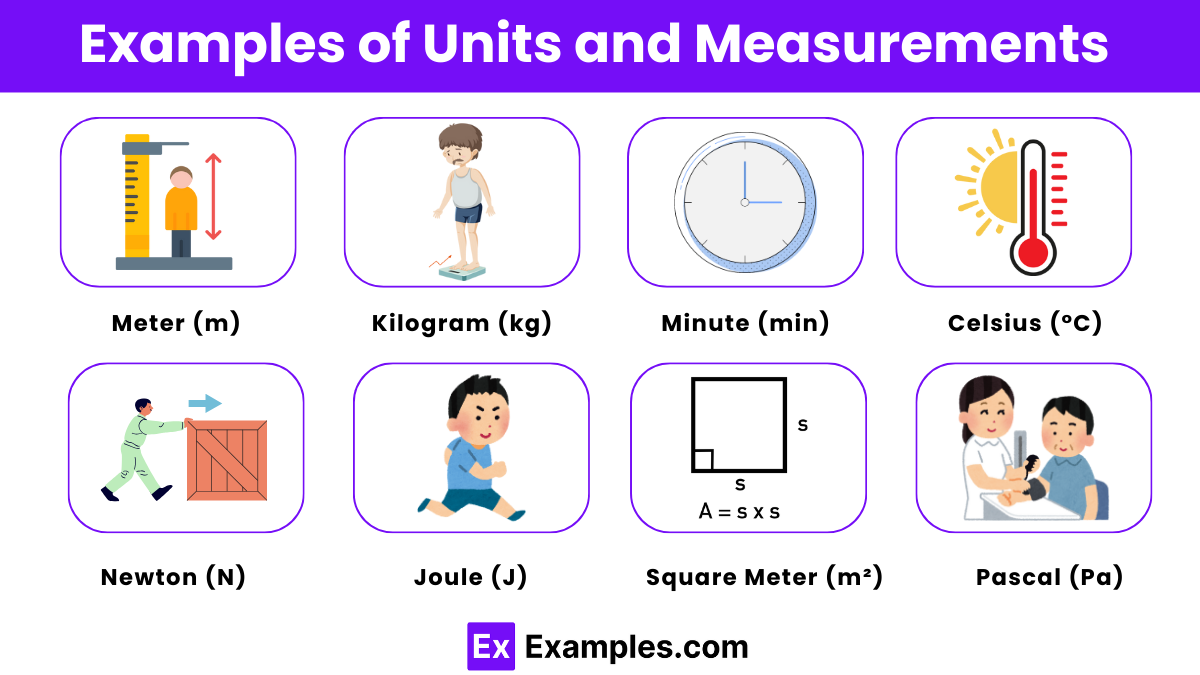What is the SI unit of mass?
Gram
Kilogram
Pound
Ounce


Units and measurements are fundamental concepts in science and daily life, providing a standardized way to quantify and communicate physical quantities. A unit is a specific magnitude of a physical quantity, defined and adopted by convention or law, that is used as a standard for measurement of the same kind of quantity. Measurements involve the comparison of the quantity with a chosen unit to express the amount or value of the quantity. The International System of Units (SI) is the most widely used system, encompassing units of measurement such as the meter for length, the kilogram for units of weight, and the second for time. Additionally, it includes specific units of density like kilograms per cubic meter, units of current such as the ampere, units of power like the watt, and units of light measured in lumens. Accurate and precise measurements are crucial for scientific experiments, engineering, commerce, and various fields, ensuring consistency, reliability, and clarity in data and communication.
Units and measurements refer to the standards and processes used to quantify physical quantities such as length, mass, time, and temperature. A unit is a specific magnitude of a physical quantity, defined and adopted by convention, that is used as a standard for measurement. Measurements involve comparing an unknown quantity with a known standard unit to express the value in terms of that unit.

| Measurement | Units |
|---|---|
| Length | Meter (m) |
| Kilometer (km) | |
| Centimeter (cm) | |
| Millimeter (mm) | |
| Micrometer (µm) | |
| Nanometer (nm) | |
| Inch (in) | |
| Foot (ft) | |
| Yard (yd) | |
| Mile (mi) | |
| Light Year (ly) | |
| Astronomical Unit (AU) | |
| Parsec (pc) | |
| Angstrom (Å) | |
| Mass | Kilogram (kg) |
| Gram (g) | |
| Milligram (mg) | |
| Microgram (µg) | |
| Nanogram (ng) | |
| Tonne (t) | |
| Pound (lb) | |
| Ounce (oz) | |
| Stone (st) | |
| Dalton (Da) | |
| Time | Second (s) |
| Minute (min) | |
| Hour (h) | |
| Day (d) | |
| Week (wk) | |
| Month (mo) | |
| Year (yr) | |
| Decade | |
| Century | |
| Millennium | |
| Electric Current | Ampere (A) |
| Temperature | Kelvin (K) |
| Degree Celsius (°C) | |
| Degree Fahrenheit (°F) | |
| Amount of Substance | Mole (mol) |
| Luminous Intensity | Candela (cd) |
| Volume | Liter (L) |
| Milliliter (mL) | |
| Cubic Meter (m³) | |
| Cubic Centimeter (cm³) | |
| Cubic Millimeter (mm³) | |
| Cubic Decimeter (dm³) | |
| Gallon (gal) | |
| Quart (qt) | |
| Pint (pt) | |
| Fluid Ounce (fl oz) | |
| Cup (cp) | |
| Tablespoon (tbsp) | |
| Teaspoon (tsp) | |
| Cubic Inch (in³) | |
| Cubic Foot (ft³) | |
| Cubic Yard (yd³) | |
| Acre-Foot | |
| Frequency | Hertz (Hz) |
| Force | Newton (N) |
| Dyne (dyn) | |
| Pressure | Pascal (Pa) |
| Atmosphere (atm) | |
| Bar (bar) | |
| Millibar (mbar) | |
| Torr (torr) | |
| Pound per Square Inch (psi) | |
| Energy | Joule (J) |
| Electronvolt (eV) | |
| British Thermal Unit (BTU) | |
| Calorie (cal) | |
| Kilocalorie (kcal) | |
| Erg | |
| Kilowatt-hour (kWh) | |
| Power | Watt (W) |
| Horsepower (hp) | |
| Electric Charge | Coulomb (C) |
| Electric Potential | Volt (V) |
| Capacitance | Farad (F) |
| Electrical Resistance | Ohm (Ω) |
| Electrical Conductance | Siemens (S) |
| Magnetic Flux | Weber (Wb) |
| Magnetic Flux Density | Tesla (T) |
| Inductance | Henry (H) |
| Luminous Flux | Lumen (lm) |
| Illuminance | Lux (lx) |
| Radioactivity | Becquerel (Bq) |
| Curie (Ci) | |
| Absorbed Dose of Radiation | Gray (Gy) |
| Rad | |
| Equivalent Dose of Radiation | Sievert (Sv) |
| Rem | |
| Catalytic Activity | Katal (kat) |
| Speed | Meter per Second (m/s) |
| Kilometer per Hour (km/h) | |
| Mile per Hour (mph) | |
| Feet per Second (ft/s) | |
| Knot (kn) | |
| Area | Square Meter (m²) |
| Square Kilometer (km²) | |
| Square Centimeter (cm²) | |
| Square Millimeter (mm²) | |
| Square Mile (mi²) | |
| Square Foot (ft²) | |
| Square Inch (in²) | |
| Acre (ac) | |
| Hectare (ha) | |
| Sound Intensity | Decibel (dB) |
| Luminance | Candela per Square Meter (cd/m²) |
Units and measurements are fundamental in science and everyday life. They ensure consistency, accuracy, and clear communication. Here are the main types of units and measurements:
Fundamental units are the basic units of measurement defined by the International System of Units (SI). They form the foundation for all other units. The seven fundamental units are:
Derived units are formed by combining fundamental units according to mathematical relationships. Examples include:
Newton (N): Measures force (kg·m/s²).
Joule (J): Measures energy (kg·m²/s²).
Watt (W): Measures power (kg·m²/s³).
Pascal (Pa): Measures pressure (kg/m·s²).
Supplementary units, though not as commonly referenced, include units like the radian (rad) for measuring plane angles and the steradian (sr) for measuring solid angles.
Non-SI units are units not part of the International System but still widely used in specific fields or regions. Examples include:
Liter (L): Measures volume.
Hour (h): Measures time.
Degree Celsius (°C): Measures temperature.
Bar: Measures pressure.
Conversion of units is essential when dealing with different measurement systems. Common conversions include:
1 inch = 2.54 centimeters
1 pound = 0.453592 kilograms
1 gallon = 3.78541 liters
The International System of Units (SI) is a globally accepted system of measurement based on seven base units like meter, kilogram, and second.
Base units are fundamental units in the SI system that describe basic physical quantities such as length, mass, time, temperature, amount of substance, electric current, and luminous intensity.
The meter is defined as the distance light travels in a vacuum in 1/299,792,458 of a second.
Dimensional analysis is a technique to convert one kind of unit to another using their dimensions, ensuring equations remain consistent in terms of units.
Significant figures reflect the precision of a measurement, indicating the number of digits that are known with certainty plus one that is estimated.
Systematic error is a consistent, repeatable error associated with faulty equipment or flawed experimental design, leading to measurements that are consistently off in the same direction.
Accuracy refers to how close a measurement is to the true value, while precision indicates the reproducibility or consistency of the measurements.
Time is measured in seconds, defined by the vibration frequency of cesium-133 atoms, with one second equal to 9,192,631,770 vibrations.
A conversion factor is a ratio used to convert a quantity from one unit to another, like 1 inch equals 2.54 centimeters.
Scientists prefer the SI system because it is based on universal constants, ensuring consistency and simplicity in international communication and scientific research.
Text prompt
Add Tone
10 Examples of Public speaking
20 Examples of Gas lighting
What is the SI unit of mass?
Gram
Kilogram
Pound
Ounce
Which unit is used to measure electric current?
Volt
Ampere
Ohm
Watt
What does one liter measure?
Mass
Length
Volume
Time
What is the unit of frequency in the SI system?
Hertz
Joule
Newton
Pascal
Which unit is used to measure temperature in the SI system?
Celsius
Kelvin
Fahrenheit
Rankine
What is the SI unit of force?
Joule
Watt
Newton
Dyne
Which unit is used to measure the amount of substance in the SI system?
Mole
Gram
Liter
Pascal
What is the SI unit of electric charge?
Coulomb
Volt
Volt
Ohm
What does the unit "kelvin" measure?
Force
Pressure
Temperature
Length
What unit is used to measure resistance in an electric circuit?
Volt
Ohm
Ampere
Henry
Before you leave, take our quick quiz to enhance your learning!

